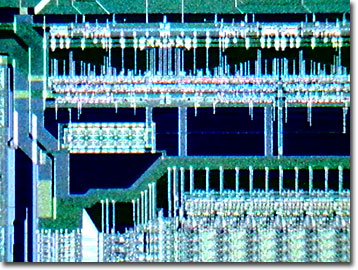Integrated Circuit Image Gallery
Texas Instruments 486 Microprocessor
In 1989, the 32-bit 486 heralded the fourth generation of microprocessors with two radical innovations: the integration of the floating-point unit on the same chip as the processing circuitry and the addition of an internal 8-Kbyte memory cache. With 1.2 million transistors on an 81-square millimeter die assembled with the available 1.0-micron complementary metal oxide semiconductor (CMOS) technology, this microprocessor took the world's PC markets by storm. This central processing unit (CPU) initially had a clock speed of 25 MHz running on 5 volts with a maximum power dissipation of 5 watts. There are many models of the 486 processor including those featuring clock doubling and tripling, and embedded and low-power versions, making the family larger than the previous 386 family.

View a second image of a Texas Instruments 486 microprocessor.
Texas Instruments (TI) released a 486 microprocessor clone in 1992. As with other licensed look-alikes, the TI 486 chip is virtually identical to Intel's original design with regard to instruction sets and performance. Although largely obsolete in the personal computer market, TI486s are featured as on-board processors for modern electronic equipment such as data acquisition processors, and are still employed in embedded applications with improved cache memories, clock speeds, and lower power requirements.
In the 1980s, anyone attempting math-intensive applications such as graphics, computer-aided design and manufacturing (CAD/CAM), or statistical modeling really appreciated the value of a math co-processor in accelerating performance. The 80486 microprocessor incorporates all the circuitry and logic of the 387 co-processor coupled with the 386 processor core on a single silicon wafer. Operating at the same clock speed as the 386-387 chip pair, the internal coprocessor of the 486 delivers about twice the performance because of increased efficiency of exchanging information in close proximity, and because of the inclusion of pipelining architecture. In other words, a 20-MHz 486 delivered about the same instruction throughput as a 40-MHz 386 chip.
Contributing Authors
Omar Alvarado, Thomas J. Fellers and Michael W. Davidson - National High Magnetic Field Laboratory, 1800 East Paul Dirac Dr., The Florida State University, Tallahassee, Florida, 32310.
BACK TO THE INTEGRATED CIRCUIT IMAGE GALLERY
BACK TO THE DIGITAL IMAGE GALLERIES
Questions or comments? Send us an email.
© 1995-2022 by Michael W. Davidson and The Florida State University. All Rights Reserved. No images, graphics, software, scripts, or applets may be reproduced or used in any manner without permission from the copyright holders. Use of this website means you agree to all of the Legal Terms and Conditions set forth by the owners.
This website is maintained by our
Graphics & Web Programming Team
in collaboration with Optical Microscopy at the
National High Magnetic Field Laboratory.
Last Modification Friday, Nov 13, 2015 at 02:19 PM
Access Count Since September 17, 2002: 7448
Visit the website of our partner in introductory microscopy education:
|
|
